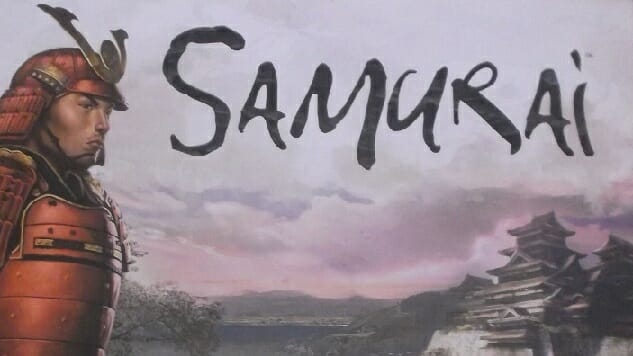Samurai Boardgame

Fantasy Flight Games’ Euro Classics series is one of the best developments in boardgame publishing in 2015, as they’re bringing back some of the best German-style games ever created and doing so with updated graphics and better packaging, making them accessible to all of the players who’ve come to the hobby in this recent explosion of popularity. Following the release this summer of the new version of Tigris and Euphrates, Fantasy Flight has now brought out a much-improved edition of Samurai, one of the top twenty games I’ve ever played, and one that has the rare benefit of playing as well with two players as it does with three or four.
Samurai, from the Prolific Reiner Knizia—the man has designed so many great games, you can’t discuss him without calling him “the Prolific”—is a very simple game that, like many Knizia titles (including Tigris and Euphrates), has math at its heart without wearing that math on its sleeve. Players compete to seize control of neutral tokens on a small board, the size of which depends on the number of players, by placing tiles of varying strengths and influences on empty hexes. There are three types of tokens—castles, rice paddies, and buddhas, two of which have changed since the first edition—and players attempt to capture those tokens by placing tiles that influence specific token types or that influence all three at once. Once a token’s hex is surrounded, the player whose adjacent tokens have the most influence on that token type gets to take the token. The tokens’ locations on the board change each game; there’s one space that has three tokens, one of each type, and the remainder are placed by the players, one at a time, until the board is filled. Most tokens stand alone on their spaces, but there are a few two-token spaces (the tokens can’t be of the same type) as well as the central “edo” space with all three.
Each player starts the game with the same twenty tiles, but only has five tokens in his/her active hand at any point; you can begin the game with randomized hands, or can allow each player to choose his/her starting hand. Eighteen of the twenty tiles bear numbers on them that represent that influence or strength mentioned above. Each player has nine tiles that show a specific token type, three in each, showing strength 2, 3 and 4 applying to buddhas, rice paddies or castles specifically; these tiles have no effect on tokens other than the ones they depict. Five more tiles show samurais and influence all three token types equally, with one tile of strength 3 and two each of strength 2 and strength 1. On a turn, a player may play only one of these tiles on an empty hex space, and once placed the tile can’t be moved, with one exception, the “move tile,” which, when played, allows a player to pick up a used tile from the board and relocate it to a new, empty space. Each player has just one move tile, so deploying it is one of the game’s many key decisions.
A player’s stack of tiles also contains five “fast” tiles, bearing a small red symbol with the Japanese character ? (hayaidesu, meaning fast), so-called because a player can play them in addition to any regular tile on a turn and may even play more than one on a turn. Three of these tiles are ships that are played on sea hexes adjacent to land, two of strength 1 and one of strength 2. These influence all token types as the samurai do, but may only be placed on sea hexes and are the only tiles that may be placed there.
-

-

-

-

-

-

-

-

-

-

-

-

-

-

-

-

-

-

-

-

-

-

-

-

-

-

-

-

-

-

-

-

-

-

-

-

-

-

-

-










































